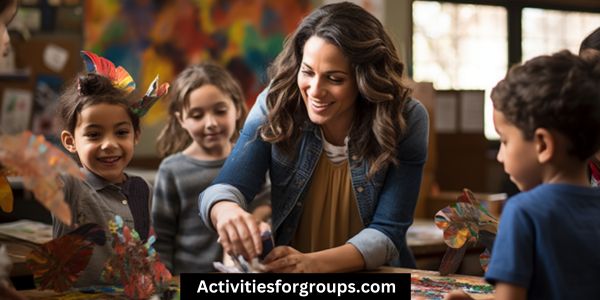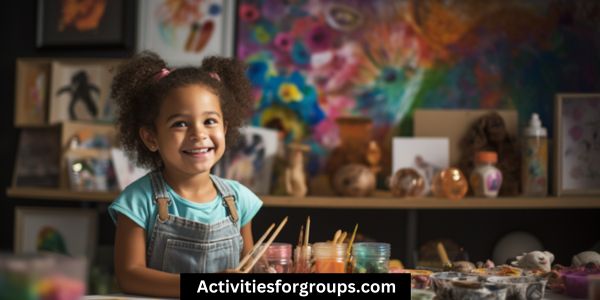Creating art with a group of kindergarten students can be a rewarding experience. You’ll need the right supplies to make it successful.
Organizing the group, coming up with creative ideas, and finding the right storage solutions are key.

Plus, safety guidelines should be followed to ensure everyone has a fun and productive time.
Get ready to let your students explore the world of art!
Art Materials
You’ll need a variety of art materials to complete group art projects in a kindergarten classroom. Exploring colors and encouraging collaboration can be fun for children, and the right materials will allow them to express themselves in a creative way.
A great starting point is to stock up on finger paints, crayons, markers, and colored pencils in bright and varied colors. These are safe for young children and will provide them with plenty of options to explore.
Additionally, construction paper, glue, scissors, and tape are necessary for constructing projects. You can also provide children with items from nature, such as leaves, flowers, and sticks, for their projects. These can be used to decorate cards and collages.
For more advanced art projects, such as clay sculptures, you’ll need a number of supplies. For this, you’ll need to purchase clay, as well as tools like rolling pins, knives, and clay cutters. You may also need to purchase glazes and paints to decorate and seal the finished product.
Finally, make sure to have paper towels, sponges, and a few large containers for cleaning up after art projects. This will help maintain a safe and sanitary environment.
With all the necessary supplies, your students will have plenty of fun creating art projects and exploring their creativity.
Group Organization
To ensure successful group art projects in a kindergarten classroom, you need to plan ahead for organization. Before assigning any tasks, it’s important to ensure that all students have the same understanding of the project’s goals and expectations. This can be done by discussing the project and allowing for questions and ideas to be shared. Once everyone is on the same page, it’s important to assign responsibilities to each student.
A great way to do this is by using a 3 column and 4 row table. The first column can list the tasks that need to be done, the second column can list the students responsible for the task, and the third column can list any necessary supplies. This will provide a clear visual of who’s responsible for what.
Having a plan for organization will help students collaborate and share responsibilities. Make sure students understand the importance of working together and why their ideas are essential for the project’s success. Encourage them to communicate their ideas and brainstorm together to create the best possible outcome. By fostering collaboration, students will learn the value of sharing responsibilities and working together to reach common goals.
Organizing group art projects in a kindergarten classroom can be a challenge. With some creative thinking and careful planning, you can ensure the project is a success. Create a plan for organization and assign tasks to each student, encourage ideas collaboration, and foster an environment of sharing responsibilities. This will help the students work together to reach their goals and create a beautiful piece of art.
Creative Ideas

Once you have a plan in place, it’s time to start thinking of creative ideas for the project. To help inspire the group, brainstorm inspiring themes to explore. Nature, animals, or a community project are all good ideas. Encourage the students to come up with their own creative ideas and be sure to include interactive activities.
For example, have the children draw pictures of their favorite animals and have them share their work with the group. Or, create an outdoor scavenger hunt to collect items from nature. When the children bring back their items, have the group create a mural with the collected items. This will help the children work together and develop their collaborative skills.
Encourage them to be creative and explore their own ideas. By allowing the children to come up with their own ideas, they’ll be more engaged and invested in the project. Utilize art supplies such as paint, markers, paper, and clay that can help the children express their creativity.
With a few simple supplies and some inspiring ideas, you can create a fun and engaging group art project for your kindergarten classroom.
Storage Solutions
When it comes to group art projects in a kindergarten classroom, it’s important to have a plan for storing supplies. Sharing materials efficiently among students is an integral part of successful projects, and space management is essential for keeping the classroom organized. To ensure supplies are kept together and accessible, consider the following storage solutions:
| Container | Benefits | Drawbacks |
|---|---|---|
| Drawer Cart | Smaller items can be organized in drawers | Limited space for larger items |
| Large Bins | Can hold more items, easy to move | Can’t see inside easily |
| Open Shelves | Easy to access materials | Not ideal for small items |
When selecting storage containers, think about the size of the items that need to be stored. For example, if the project requires larger items, a drawer cart might not be the best solution. On the other hand, if the materials are small, open shelves may not be the best choice.
Safety Guidelines

Before beginning a group art project in a kindergarten classroom, it’s important to review safety guidelines for the materials and supplies being used. Fostering trust between students and teachers and creating a safe learning environment is essential for success. It’s also important to involve the students in the process of creating the safety guidelines. Working together can make students feel more involved and help to build a sense of community.
When selecting supplies and materials for a group art project, it’s important to understand that some items may present a hazard, and safety should be the top priority. For example, scissors, glue, and paints should be used with caution. It’s important to supervise children at all times and have clear rules in place to ensure everyone is safe.
When it comes to storage, it’s important to make sure that any hazardous materials are securely stored away from the children and out of reach. Any tools or supplies that aren’t in use should also be put away. Finally, when the project is finished, the materials should be cleaned up and stored in their designated places.
Safety should always be the top priority when it comes to any kind of group art project in a kindergarten classroom. By fostering trust between students and teachers, working together to create safety guidelines, and ensuring that materials are stored and handled properly, the project can be successful and enjoyable for everyone.
Frequently Asked Questions
What Is the Best Way to Introduce Young Kids to Art Projects?
Engage young kids in art projects by encouraging them to work collaboratively, share ideas, and build their self esteem. Have them create something together and celebrate their achievements!
How Can Teachers Motivate Their Students to Work Together on Art Projects?
Encourage your students to use collaborative strategies and explore art together. Provide positive reinforcement to motivate them to work together.
How Can Teachers Encourage Creative Thinking in a Group Art Project?
Encourage creative thinking by providing praise, allowing collaboration, and building self esteem. Invite students to share ideas and provide open-ended questions to spark creativity.
What Are Some Age-Appropriate Art Projects for Kindergarteners?
Explore engaging activities with your kindergarteners like exploring textures! Let them use their imagination and get creative!
What Are Some Tips for Dealing With Messy Art Projects in the Classroom?
Encourage creative expression by encouraging collaboration among kindergarteners. Provide aprons and smocks to protect clothing and equipment. Have a designated area for art with paper towels and wipes handy to quickly clean up messes.
Conclusion
You’re now ready to get your group art projects started in your kindergarten classroom!
You have the art materials, a plan for organization, lots of creative ideas, and storage solutions.
As long as you adhere to the safety guidelines, you and your students will have a great time getting creative together.
Let the fun begin!




Leave a Reply